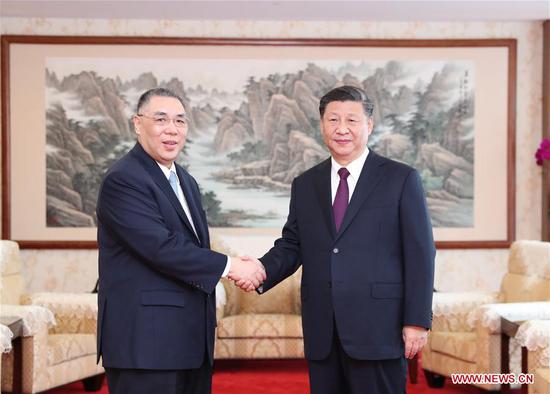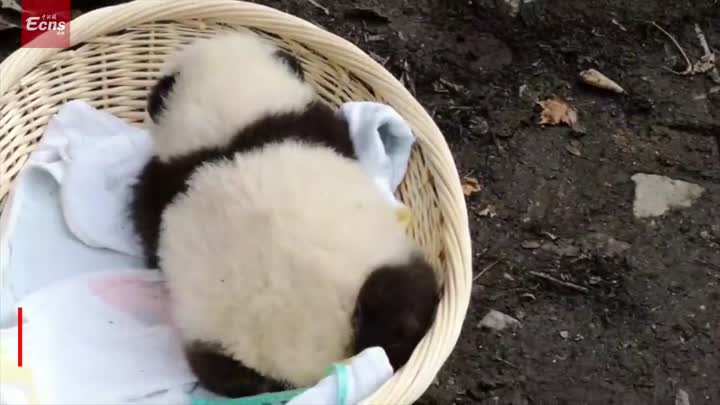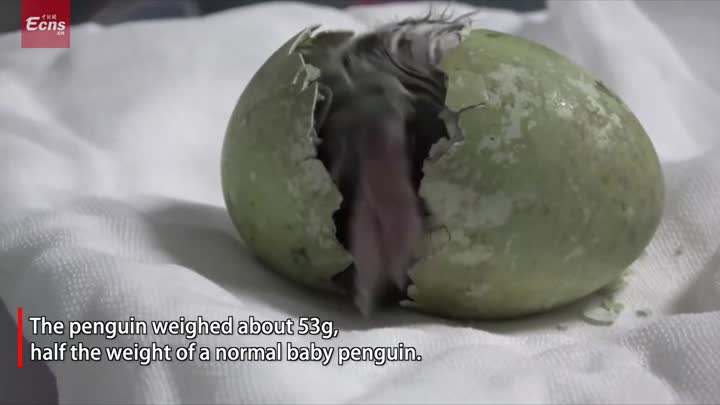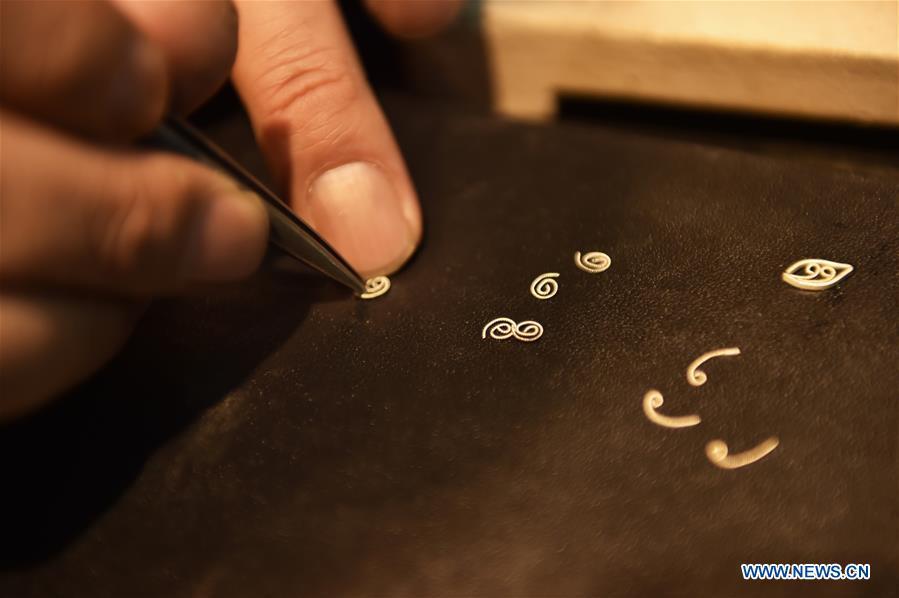
Dong Ruijing works on a piece of filigree inlay artwork in Beijing, capital of China, Dec. 17, 2019. Filigree inlay is crowned as one of the eight traditional arts and crafts of Beijing. With gold or silver as raw material, filigree inlay craftsmen apply complex techniques such as knitting and welding so as to shape metal wires into various forms. Then they create fluted patterns on the wires with techniques such as hollowing and cutting for gems to be inserted. Once a royal technique, filigree inlay is listed as one of the national intangible culture heritage. Dong Ruijing has been working on filigree inlay for over 30 years. His artwork have been recognized and rewarded in various competitions and expo committees. In recent years, Dong has been promoting and innovating this technique so that it can be known and favored by more people and the traditional culture be passed down. (Xinhua/Chen Zhonghao)
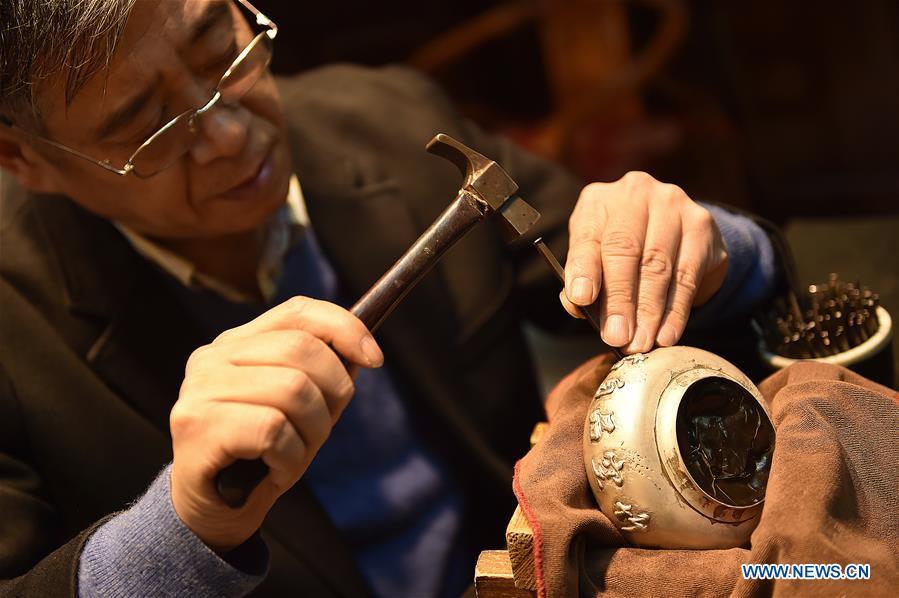
Dong Ruijing engraves Chinese characters on a piece of filigree inlay silver artwork in Beijing, capital of China, Dec. 17, 2019. Filigree inlay is crowned as one of the eight traditional arts and crafts of Beijing. With gold or silver as raw material, filigree inlay craftsmen apply complex techniques such as knitting and welding so as to shape metal wires into various forms. Then they create fluted patterns on the wires with techniques such as hollowing and cutting for gems to be inserted. Once a royal technique, filigree inlay is listed as one of the national intangible culture heritage. Dong Ruijing has been working on filigree inlay for over 30 years. His artwork have been recognized and rewarded in various competitions and expo committees. In recent years, Dong has been promoting and innovating this technique so that it can be known and favored by more people and the traditional culture be passed down. (Xinhua/Chen Zhonghao)
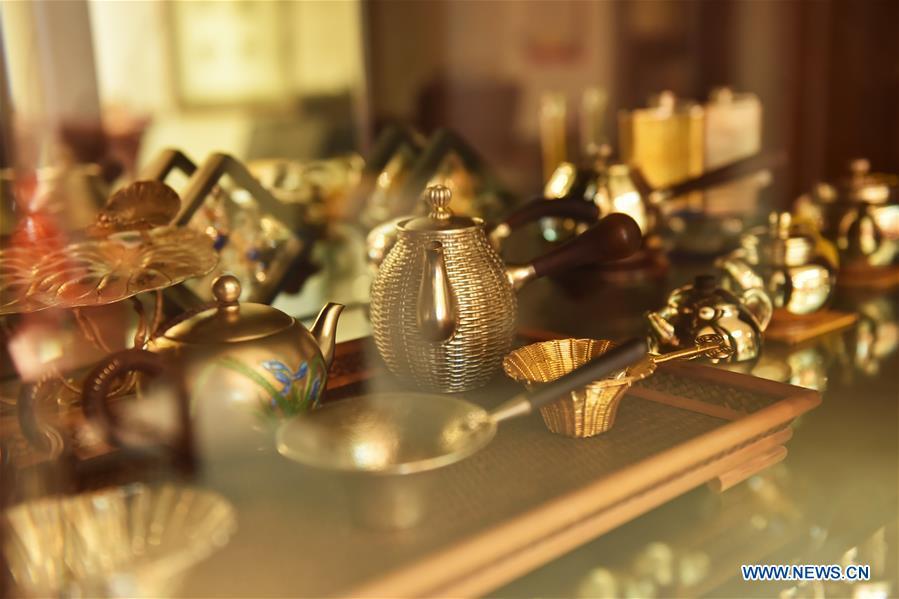
Photo taken on Dec. 17, 2019 shows filigree inlay articles exhibited at Dong Ruijing's studio in Beijing, capital of China. Filigree inlay is crowned as one of the eight traditional arts and crafts of Beijing. With gold or silver as raw material, filigree inlay craftsmen apply complex techniques such as knitting and welding so as to shape metal wires into various forms. Then they create fluted patterns on the wires with techniques such as hollowing and cutting for gems to be inserted. Once a royal technique, filigree inlay is listed as one of the national intangible culture heritage. Dong Ruijing has been working on filigree inlay for over 30 years. His artwork have been recognized and rewarded in various competitions and expo committees. In recent years, Dong has been promoting and innovating this technique so that it can be known and favored by more people and the traditional culture be passed down. (Xinhua/Chen Zhonghao)
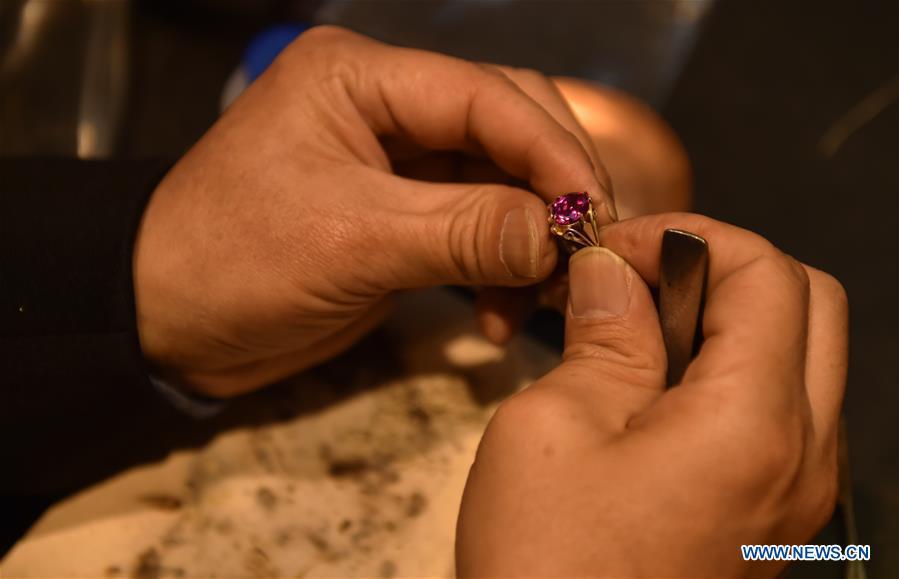
Dong Ruijing works on a piece of filigree inlay artwork in Beijing, capital of China, Dec. 17, 2019. Filigree inlay is crowned as one of the eight traditional arts and crafts of Beijing. With gold or silver as raw material, filigree inlay craftsmen apply complex techniques such as knitting and welding so as to shape metal wires into various forms. Then they create fluted patterns on the wires with techniques such as hollowing and cutting for gems to be inserted. Once a royal technique, filigree inlay is listed as one of the national intangible culture heritage. Dong Ruijing has been working on filigree inlay for over 30 years. His artwork have been recognized and rewarded in various competitions and expo committees. In recent years, Dong has been promoting and innovating this technique so that it can be known and favored by more people and the traditional culture be passed down. (Xinhua/Chen Zhonghao)
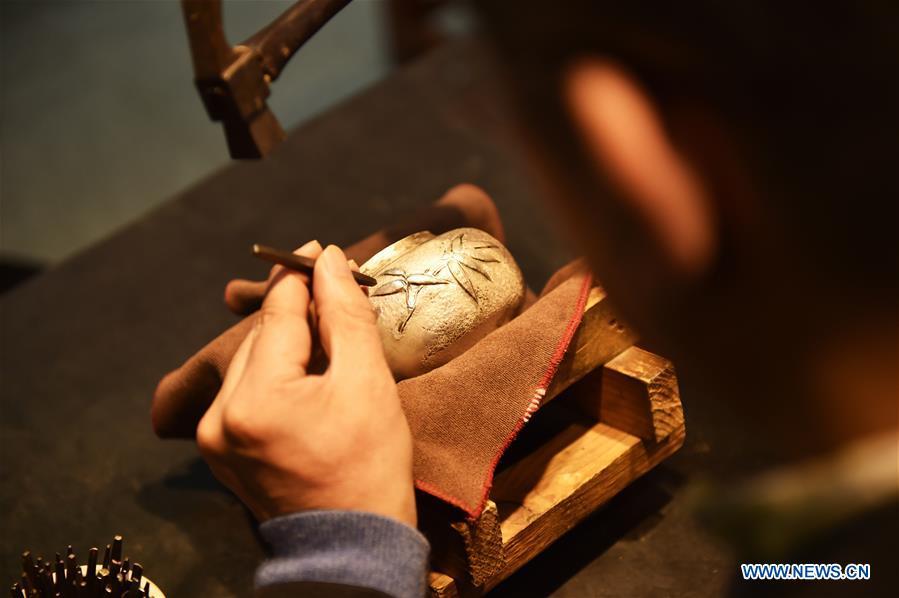
Dong Ruijing engraves bamboo leaves patterns on a piece of filigree inlay silver artwork in Beijing, capital of China, Dec. 17, 2019. Filigree inlay is crowned as one of the eight traditional arts and crafts of Beijing. With gold or silver as raw material, filigree inlay craftsmen apply complex techniques such as knitting and welding so as to shape metal wires into various forms. Then they create fluted patterns on the wires with techniques such as hollowing and cutting for gems to be inserted. Once a royal technique, filigree inlay is listed as one of the national intangible culture heritage. Dong Ruijing has been working on filigree inlay for over 30 years. His artwork have been recognized and rewarded in various competitions and expo committees. In recent years, Dong has been promoting and innovating this technique so that it can be known and favored by more people and the traditional culture be passed down. (Xinhua/Chen Zhonghao)
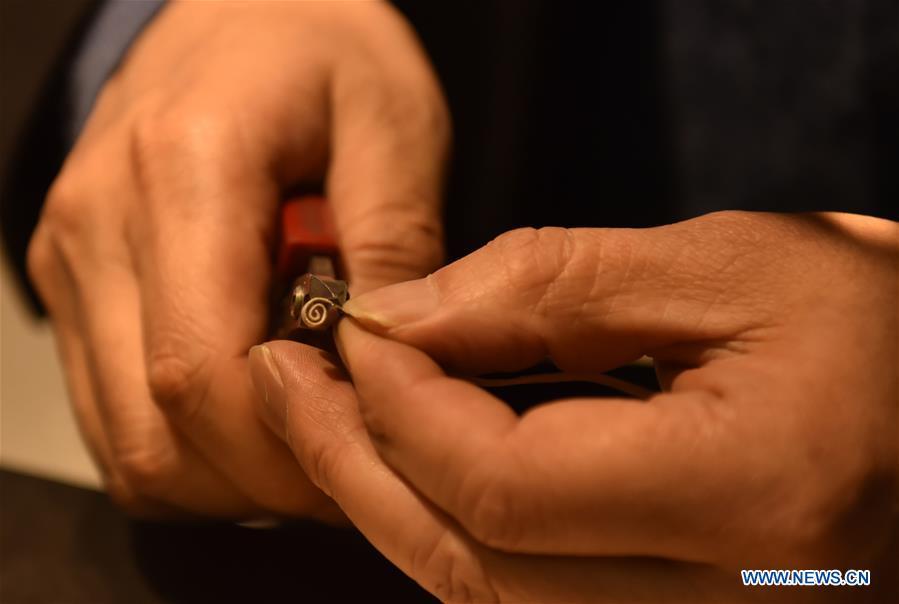
Dong Ruijing works on a piece of filigree inlay artwork in Beijing, capital of China, Dec. 17, 2019. Filigree inlay is crowned as one of the eight traditional arts and crafts of Beijing. With gold or silver as raw material, filigree inlay craftsmen apply complex techniques such as knitting and welding so as to shape metal wires into various forms. Then they create fluted patterns on the wires with techniques such as hollowing and cutting for gems to be inserted. Once a royal technique, filigree inlay is listed as one of the national intangible culture heritage. Dong Ruijing has been working on filigree inlay for over 30 years. His artwork have been recognized and rewarded in various competitions and expo committees. In recent years, Dong has been promoting and innovating this technique so that it can be known and favored by more people and the traditional culture be passed down. (Xinhua/Chen Zhonghao)
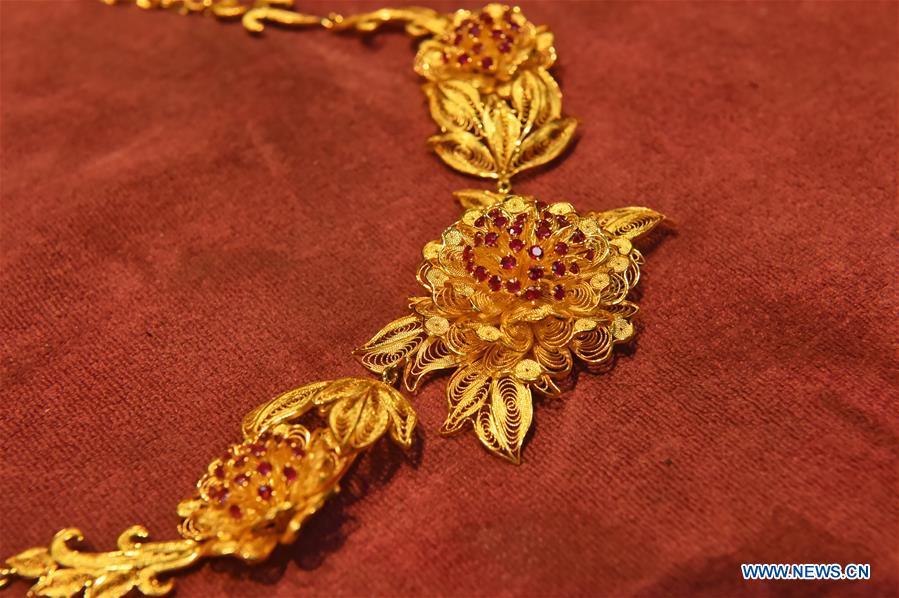
Photo taken on Dec. 17, 2019 shows a filigree inlay necklace in Beijing, capital of China. Filigree inlay is crowned as one of the eight traditional arts and crafts of Beijing. With gold or silver as raw material, filigree inlay craftsmen apply complex techniques such as knitting and welding so as to shape metal wires into various forms. Then they create fluted patterns on the wires with techniques such as hollowing and cutting for gems to be inserted. Once a royal technique, filigree inlay is listed as one of the national intangible culture heritage. Dong Ruijing has been working on filigree inlay for over 30 years. His artwork have been recognized and rewarded in various competitions and expo committees. In recent years, Dong has been promoting and innovating this technique so that it can be known and favored by more people and the traditional culture be passed down. (Xinhua/Chen Zhonghao)
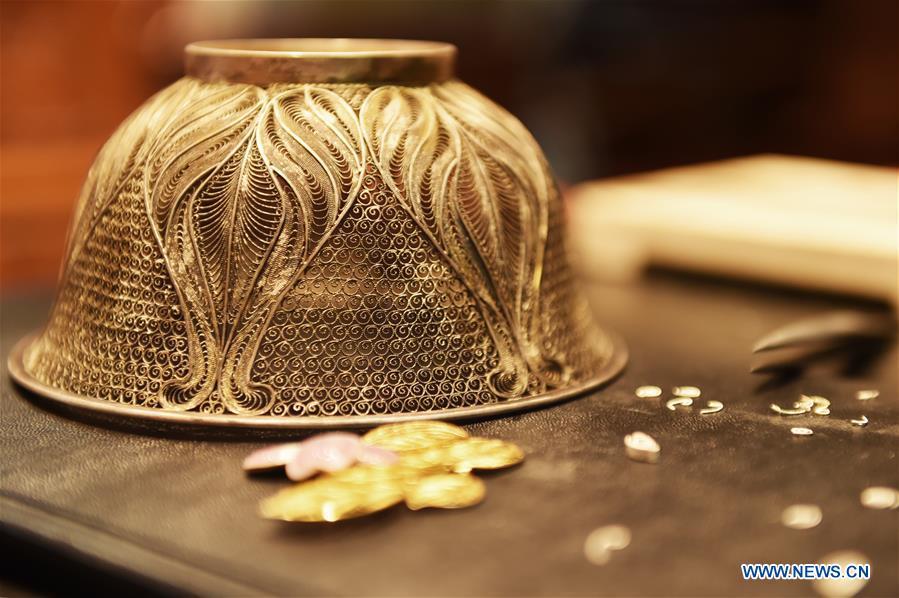
Photo taken on Dec. 17, 2019 shows a silver bowl made with filigree inlay techniques in Beijing, capital of China. Filigree inlay is crowned as one of the eight traditional arts and crafts of Beijing. With gold or silver as raw material, filigree inlay craftsmen apply complex techniques such as knitting and welding so as to shape metal wires into various forms. Then they create fluted patterns on the wires with techniques such as hollowing and cutting for gems to be inserted. Once a royal technique, filigree inlay is listed as one of the national intangible culture heritage. Dong Ruijing has been working on filigree inlay for over 30 years. His artwork have been recognized and rewarded in various competitions and expo committees. In recent years, Dong has been promoting and innovating this technique so that it can be known and favored by more people and the traditional culture be passed down. (Xinhua/Chen Zhonghao)
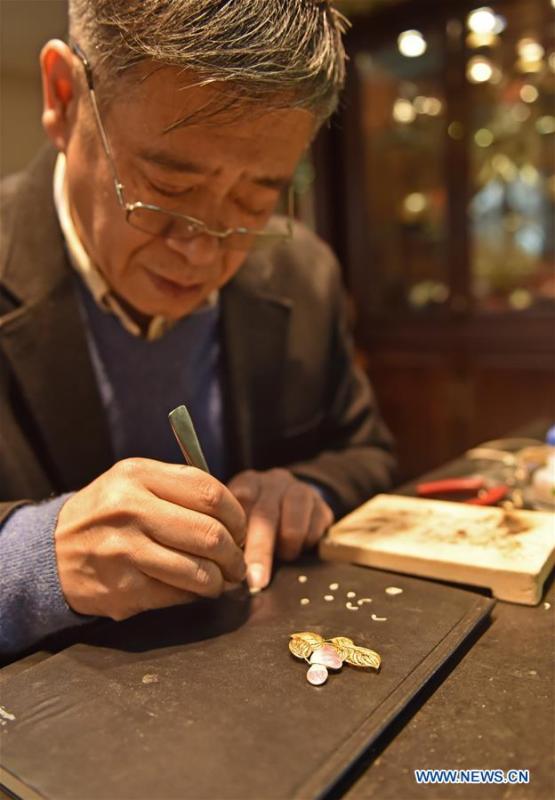
Dong Ruijing works on a piece of filigree inlay work in Beijing, capital of China, Dec. 17, 2019. Filigree inlay is crowned as one of the eight traditional arts and crafts of Beijing. With gold or silver as raw material, filigree inlay craftsmen apply complex techniques such as knitting and welding so as to shape metal wires into various forms. Then they create fluted patterns on the wires with techniques such as hollowing and cutting for gems to be inserted. Once a royal technique, filigree inlay is listed as one of the national intangible culture heritage. Dong Ruijing has been working on filigree inlay for over 30 years. His artwork have been recognized and rewarded in various competitions and expo committees. In recent years, Dong has been promoting and innovating this technique so that it can be known and favored by more people and the traditional culture be passed down. (Xinhua/Chen Zhonghao)














